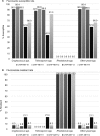Five-year China Hospital Invasive Fungal Surveillance Net (CHIF-NET) study of invasive fungal infections caused by noncandidal yeasts: species distribution and azole susceptibility
- PMID: 30349323
- PMCID: PMC6183553
- DOI: 10.2147/IDR.S173805
Five-year China Hospital Invasive Fungal Surveillance Net (CHIF-NET) study of invasive fungal infections caused by noncandidal yeasts: species distribution and azole susceptibility
Abstract
Purpose: In this study, we report results from a 5-year surveillance for noncandidal yeast species causing invasive infections from 65 hospitals in China.
Materials and methods: Species identification was carried out by matrix-assisted laser desorption/ionization-time of flight mass spectrometry (MALDI-TOF MS) supplemented by rDNA sequencing, and fluconazole and voriconazole susceptibilities of yeasts were determined by Clinical and Laboratory Standards Institute (CLSI) disk diffusion methods.
Results: Overall, 884 noncandidal isolates belonging to 38 species were collected. Cryptococcus neoformans was the most common (75.6%), which also comprised 96.5% of the isolates from cerebrospinal fluid (CSF) and 62.6% from blood, followed by Trichosporon asahii (6.9%) and Rhodotorula mucilaginosa (5.1%). Fluconazole susceptibility and resistant rates were 74.1% and 9.7% for C. neoformans and 81.0% and 5.2% for T. asahii. Voriconazole exhibited good activity in comparison to these two species (99.5% and 98.3% of the isolates, were susceptible). However, 100% of the R. mucilaginosa isolates were resistant to both azoles. Other noncandidal yeast species showed reduced susceptibility to fluconazole (53.3%) but most were susceptible to voriconazole (94.3%). Over the 5 years, a decrease in the proportion of fluconazole-susceptible isolates was observed for C. neoformans (90%-67%, P<0.001) and other noncandidal yeast species (91%-66%, P<0.001). Moreover, the prevalence of azole-resistant R. mucilaginosa increased from 1% to 7% (P<0.001).
Conclusion: The shift in azole susceptibilities in mainland China calls for continued surveillance for noncandidal yeasts.
Keywords: China; azole susceptibility; epidemiology; invasive fungal infections; noncandidal yeasts.
Conflict of interest statement
Disclosure The authors report no conflicts of interest in this work.
Figures


References
-
- Miceli MH, Díaz JA, Lee SA. Emerging opportunistic yeast infections. Lancet Infect Dis. 2011;11(2):142–151. - PubMed
-
- Schwartz S, Kontoyiannis DP, Harrison T, Ruhnke M. Advances in the diagnosis and treatment of fungal infections of the CNS. Lancet Neurol. 2018;17(4):362–372. - PubMed
-
- Pande A, Non LR, Romee R, Santos CAQ. Pseudozyma and other non-Candida opportunistic yeast bloodstream infections in a large stem cell transplant center. Transplant Infectious Disease. 2017;19(2):e12664. - PubMed
-
- Kullberg BJ, Arendrup MC. Invasive Candidiasis. N Engl J Med. 2015;373(15):1445–1456. - PubMed
-
- Limper AH, Adenis A, Le T, Harrison TS. Fungal infections in HIV/ AIDS. Lancet Infect Dis. 2017;17(11):e334–e343. - PubMed
LinkOut - more resources
Full Text Sources

